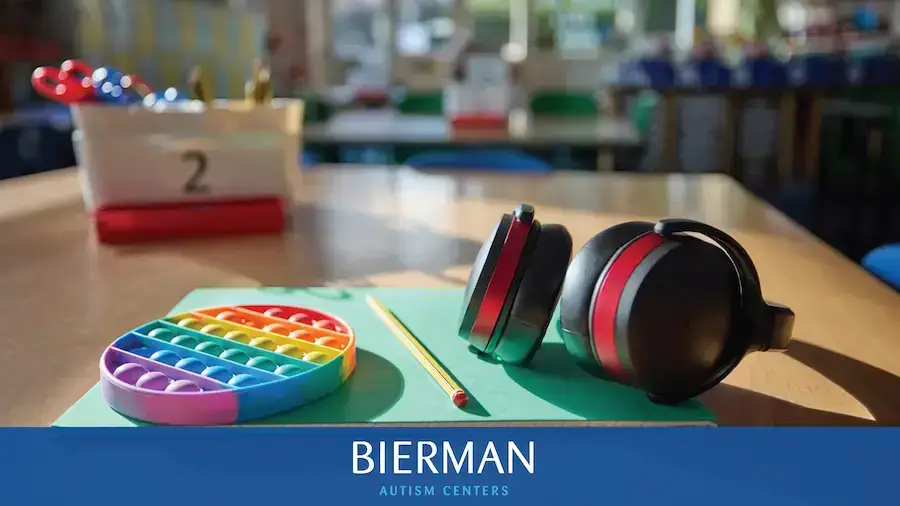About 15% of the public school population receives special education services under the Individuals with Disabilities Education Act (IDEA), with 13% qualifying due to an autism spectrum disorder (ASD) (Shaw et al., 2025). As the prevalence of autism continues to rise—with 1 in 31 children diagnosed—educators face an increasing responsibility and opportunity to create inclusive, supportive learning environments.
Recognizing the Unique Needs of Students with Autism
- Communication skills
- Social interactions
- Transitions between activities
- Sensory processing
- Self-regulation
Sensory-Friendly Classroom for Students with Autism
Children with autism tend to experience the sensory world differently from their neurotypical peers. Many classroom elements, like bright lights, background noise, and crowded spaces, can become overwhelming and distracting. Modifying the environment can help them feel more comfortable and engage in learning.
Consider the following ideas to modify the classroom environment to make it more sensory-friendly.
Lighting: Use natural lighting when possible. Consider fluorescent light covers and/or adjustable lighting to dim the brightness.
Environmental noise: Classrooms can get noisy. While eliminating all background noise isn’t always possible, there are ways to proactively prepare so students can escape or avoid sensory overload, especially during times of anticipated increased sound levels.
Here are a few ideas:
Allow students to use noise-canceling headphones. Keep extra pairs handy.
Play white noise to drown out auditory overload.
Create a quiet, calming space where students can take a sensory break when needed.
Visual input: Minimize visual clutter on walls and surfaces, which can overwhelm children with sensory sensitivities and take away from their ability to attend to the classroom stimuli that they need to learn.
Smells: Be mindful of scents in the classroom, avoiding heavy perfumes, strong air fresheners, or essential oils. Strong smells can be overstimulating for some children.
Inclusive Classroom Setup
Creating a sensory-friendly classroom is essential for students with autism—but an autism-friendly classroom goes beyond sensory accommodations. Educators and therapists should design a space that is conducive to learning with the students’ unique communication and social needs in mind. Consider the following strategies for a supportive environment.
Offer flexible seating options: Provide a variety of seating choices to support comfort and focus. Consider options like wobble stools, bean bags, cushions, and standing desks.
Use visual supports: Visual aids offer students predictability in their day, reducing anxiety surrounding transitions while promoting independence. Implement visual schedules, visual timers, and other supports to clarify expectations and guide students through their day.
Implement predictable daily routines: Consistent routines help students with autism feel secure and understand what to expect. A clear, structured schedule minimizes uncertainty.
Provide sensory tools: Many students with autism are drawn to certain textures and sensory experiences. Offer fidget toys and other tactile tools to support focus.
Build in movement breaks: Ensure there are several opportunities for students to move their bodies throughout the day.
There are many ways to encourage movement throughout the school day, including:
- Incorporate movement into classroom activities.
- Offer “brain breaks” where the class dances, does yoga, or engages in other movement activities.
- Assign classroom jobs that involve movement, such as passing out materials or delivering notes to the office.
- Create a movement station for students to gain sensory input, with things like balance boards or stepping stones.
Use classroom-wide positive reinforcement: Intentionally acknowledge and reinforce positive behaviors using a structured reinforcement system that benefits all students rather than singling out those with special needs. While this system should include everyone, remember that reinforcement is not a one-size-fits-all. Tailor reinforcers and reinforcement schedules to meet each student’s needs and preferences.
Support alternative and augmentative communication (AAC): Encourage a positive learning experience by ensuring every student has a voice—whether they communicate via spoken language, picture icons, a speech-generating device, or another modality.
Foster Belonging & Inclusion
Educators can create a neurodiversity-affirming classroom by cultivating a culture of acceptance and inclusion. Encourage peer connections through structured group activities that include everyone. Celebrate neurodiversity, encouraging students to recognize the unique strengths everyone brings to the table. Additionally, help students understand that everyone learns differently and that different learning styles should be respected.
Collaborate for Student Success
Creating an autism-friendly classroom requires planning and a team effort. Environmental modifications and structured interventions are essential, though no one-size-fits-all approach exists. Every student has unique strengths, challenges, and preferences. Understanding what each student needs requires collaboration. Work closely with parents, ABA therapists, and the entire IEP team to design personalized and effective strategies tailored to each student’s needs. By working together as a team, you can help your students achieve the best possible outcomes.
References
Shaw, K. A., Williams, S., Patrick, M. E., et al. (2025). Prevalence and early identification of autism spectrum disorder among children aged 4 and 8 years — Autism and Developmental Disabilities Monitoring Network, 16 sites, United States, 2022. MMWR Surveillance Summaries, 74(No. SS-2), 1–22. https://doi.org/10.15585/mmwr.ss7402a1
Lundström, S., Lichtenstein, P., Gillberg, C., Larsson, H., & Anckarsäter, H. (2023). Comorbidity and cognitive profile in autism spectrum disorder: A population-based twin study. Translational Psychiatry, 13(1), Article 234. https://www.nature.com/articles/s41398-023-02374-w
National Center for Education Statistics. (2024). Students With Disabilities. Condition of Education. U.S. Department of Education, Institute of Education Sciences. Retrieved [date], from https://nces.ed.gov/programs/coe/indicator/cgg.


